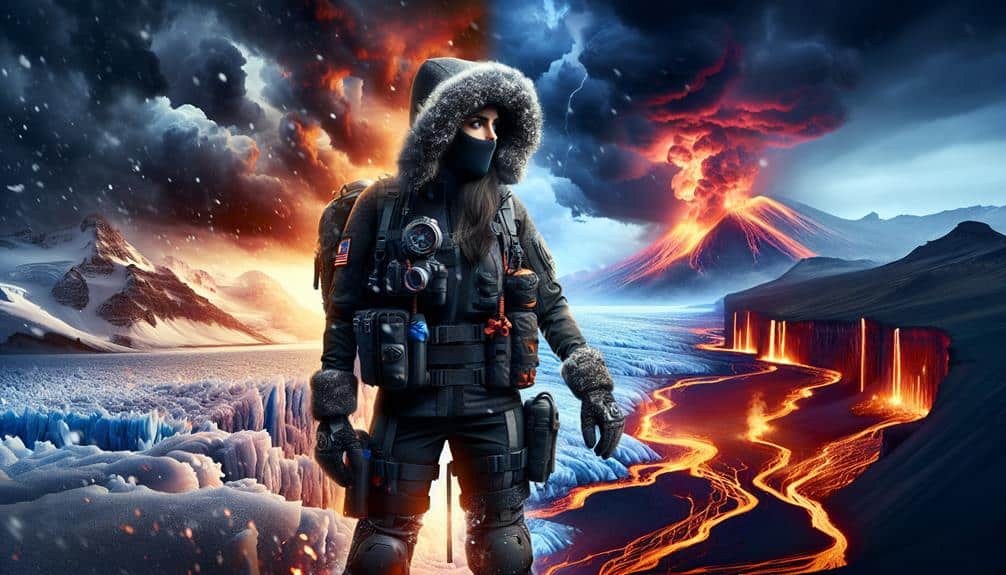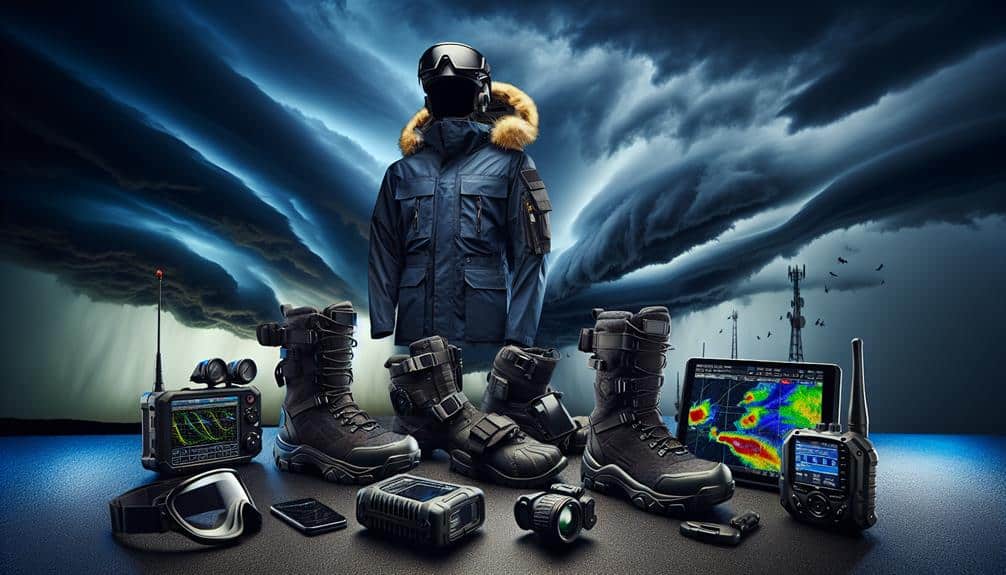As storm chasers, we must meticulously prepare to survive extreme temperatures. We dress in layers, starting with moisture-wicking base layers, insulating middle layers, and waterproof outer shells. Staying hydrated is vital, so we drink 16-20 ounces of water per hour and include electrolyte-rich drinks. Sun protection involves applying SPF 30 sunscreen, wearing UV-protective sunglasses, and seeking shade. Monitoring weather conditions with real-time data helps us stay ahead. We also pack detailed emergency kits and know the signs of heat exhaustion and hypothermia. By following these strategies, we can effectively tackle the challenges posed by extreme weather during our pursuits.
Key Points
- Layer clothing to regulate temperature, with a moisture-wicking base, insulating middle, and waterproof outer shell.
- Drink 16-20 ounces of water per hour and include electrolyte-rich beverages.
- Apply sunscreen SPF 30+ and wear UV-protective sunglasses and wide-brimmed hats.
- Monitor weather conditions using meteorological tools and portable weather stations.
Dress Appropriately
To withstand extreme temperatures while storm chasing, we must prioritize layering our clothing to regulate body heat effectively. By using a multi-layer approach, we can adapt swiftly to fluctuating weather conditions.
The base layer should be moisture-wicking to keep sweat away from our skin, making sure we remain dry. A middle insulating layer, such as a fleece or down jacket, helps trap body heat. Finally, a waterproof and windproof outer shell protects us from rain and high winds.
Selecting proper footwear is equally essential. Our boots should be insulated, waterproof, and provide ankle support to navigate rugged terrains safely. Breathability is vital to prevent overheating and blisters. Additionally, quality socks made of wool or synthetic fibers offer better insulation and moisture management than cotton.
Each layer of clothing plays a distinct role. Removing or adding layers allows us to maintain an ideal body temperature, preventing both hypothermia and overheating. This strategic approach to dressing doesn't just enhance comfort but also ensures we're prepared for any weather scenario we might encounter.
Stay Hydrated
While chasing storms, we must prioritize staying hydrated to maintain cognitive function and physical performance in extreme temperatures. Dehydration can impair judgment, coordination, and reaction times, which are essential in our line of work. To mitigate these risks, adhering to effective hydration tips is necessary.
First, we should always carry ample water supplies. Aim to drink at least 16-20 ounces of water every hour. This is particularly important in high heat environments where perspiration rates increase. Additionally, incorporating electrolyte-rich beverages can help replenish sodium, potassium, and other essential minerals lost through sweat.
Monitoring urine color is a practical method to gauge hydration levels. Pale yellow indicates adequate hydration, while dark yellow suggests a need for more fluids. We should also avoid diuretics like caffeine and alcohol, which worsen dehydration.
Recognizing early signs of heat exhaustion is vital. Symptoms include dizziness, excessive sweating, and muscle cramps. If these occur, we must take immediate action: cease activity, move to a shaded area, and hydrate progressively.
Maintaining hydration isn't just about preventing discomfort; it's about ensuring we can continue our pursuit of storms safely and effectively. Let's keep our bodies and minds sharp by staying properly hydrated.
Use Sun Protection
Effective sun protection is pivotal for storm chasers to prevent sunburn, skin damage, and long-term health risks. When we're out chasing storms, exposure to UV rays can be intense, even on cloudy days. Here's a precise, technical guide on how to protect ourselves effectively.
- Apply sunscreen: Choose a broad-spectrum sunscreen with an SPF of at least 30. It's essential to apply it generously to all exposed skin 15 minutes before heading out. Reapply every two hours, or more frequently if we're sweating or getting wet.
- Wear sunglasses: UV-protective sunglasses are non-negotiable. They shield our eyes from harmful rays and reduce the risk of cataracts and other eye conditions. Look for sunglasses that block 99% to 100% of UVA and UVB rays.
- Cover up: Lightweight, long-sleeved clothing and wide-brimmed hats provide an additional layer of defense against the sun. Opt for fabrics with a high Ultraviolet Protection Factor (UPF) rating.
- Seek shade: Whenever possible, take breaks under shade structures or inside vehicles. This reduces the cumulative exposure to UV radiation, giving our skin a chance to recover.
Monitor Weather Conditions
How do we secure our safety and effectiveness as storm chasers? The answer lies in diligent weather monitoring and precise storm tracking. We rely on high-quality meteorological tools and real-time data to stay ahead of unpredictable weather patterns. Accessing satellite imagery, radar systems, and advanced weather forecasting models allows us to pinpoint storm developments accurately.
We use portable weather stations to measure temperature, humidity, and wind speed on the ground. This data is essential for understanding microclimates and predicting severe weather behavior. Mobile apps and software provide real-time updates and alerts, ensuring we're always informed about sudden changes.
Storm tracking is our lifeline. By analyzing storm cells' speed, direction, and intensity, we can make informed decisions about positioning and movement. GPS-enabled devices help us navigate safely while maintaining an ideal distance from the storm's core.
We also collaborate with meteorological agencies and fellow storm chasers to share information and insights. This collective knowledge enhances our situational awareness and decision-making capabilities.
In essence, our freedom and safety depend on a meticulous approach to weather monitoring and storm tracking. By leveraging technology and data, we make sure that we're prepared for whatever nature throws our way.
Emergency Preparedness

Emergency readiness is necessary for minimizing risks and safeguarding our safety during storm chasing missions. When we're out in extreme conditions, the difference between staying safe and facing serious health risks often comes down to our preparation.
To handle the unpredictable nature of storm chasing, we must be ready for both heat exhaustion and cold exposure.
Here are four essential steps for emergency readiness:
1. Identify Emergency Shelters:
We need to know the locations of nearby emergency shelters before we head out. Whether it's a sturdy building or a designated storm shelter, having a plan ensures we can quickly find a safe place if the situation deteriorates.
2. Pack a Complete Emergency Kit:
Our emergency kit should include essentials like first aid supplies, water, non-perishable food, and thermal blankets. These items help us manage both heat exhaustion and cold exposure, providing immediate relief and support.
3. Wear Appropriate Clothing:
Dressing in layers is vital. We can remove layers to prevent heat exhaustion in hot conditions or add them to combat cold exposure. Technical fabrics that wick moisture are particularly effective.
4. Monitor Essential Signs:
We should use portable devices to keep track of our body temperature and hydration levels. Early detection of heat exhaustion or hypothermia allows us to take swift action and seek emergency shelter if necessary.
Frequently Asked Questions
How Do You Maintain Your Vehicle in Extreme Weather Conditions?
We maintain our vehicle in extreme weather by insulating equipment and performing regular engine maintenance. This guarantees peak performance, reduces the risk of breakdowns, and keeps us moving freely without disruptions.
What Are the Best Tools for Tracking Storms in Real-Time?
When it comes to storm tracking, we prefer the finest tools: storm tracking software paired with GPS technology, complemented by weather radar and satellite imagery. These tools give us the freedom to chase safely and effectively.
How Do You Protect Your Electronics From Extreme Temperatures?
To protect our electronics from extreme temperatures, we use insulating cases and backup batteries. We also rely on climate-controlled storage and temperature alarms to maximize performance and avoid any damage due to temperature fluctuations.
What Should You Eat to Maintain Energy Levels During a Storm Chase?
We should prioritize energy-boosting snacks and hydration strategies. Effective meal planning and nutritional supplements are essential. This approach guarantees sustained energy levels, enabling us to maximize our freedom and efficiency during intense storm chases.
How Do You Handle Encounters With Wildlife During Storm Chasing?
Facing wildlife encounters is like maneuvering a minefield. We prioritize safety precautions, using observation techniques to understand wildlife behavior and avoid danger. Staying calm and respecting their space guarantees both our safety and freedom to continue pursuing.


